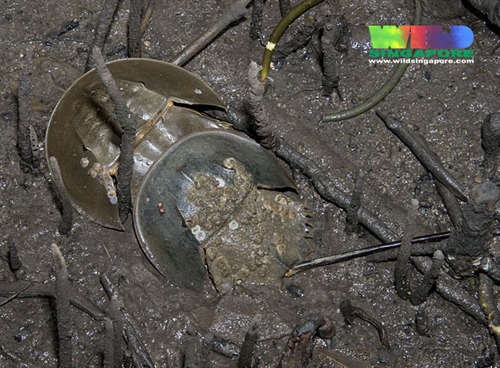
Back
Carcinoscorpius rotundicauda (Latreille, 1802)
| Family Name: | Limulidae |
| Taxonomic Group: | Invertebrates (Crustacean, Crab and Prawn) |
| Common Name: | Mangrove Horseshoe Crab |
Name
Description
| Description | Grows up to an average diameter of 150mm. Smaller than the Coastal horseshoe crab (Tachypleus gigas). Has a brown shell and tail is circular in cross-section. Eggs are often laid in the upper reaches of mangrove. |
|---|
Ecology, Habitat & Location
| Ecological Notes | Tachypleus gigas occur in sandy to muddy shores, and is normally seen when they come up to the edge of the shore to breed. Carcinoscorpius rotundicauda occur in mangroves, where significant numbers of juveniles are observed seasonally. |
|---|---|
| Habitats | Mangroves, Marine, Mudflats, Sandy Shore |
| Distribution | These species occur throughout this region. |
Conservation
| Trends & Threats | The loss of suitable sandy beach and mangrove habitats for breeding and pollution threatens the survival of these species. |
|---|---|
| Scientific Interest & Potential Value | The blood of horseshoe crabs can be purified to yield a special and very valuable commercial serum which can be used to detect bacterial toxins. The eggs are eaten occasionally, but have been known to be mildly poisonous. Horseshoe crabs are the most ancient of the chelicerates, the group which includes spiders and their allies. |
| Conservation Notes | The retention of suitable stretches of sandy, unpolluted beaches and mangroves is necessary to ensure the survival of these animals. The collection of these species for food or research should also be monitored. In the last two decades, many good natural shorelines have been developed or “improved” through a variety of “beach improvement” schemes, reclamation and other developments, so much so that Tachypleus gigas (as figured) has become less common, and the species should be regarded as endangered in the Singapore context. The mangrove species, Carcinoscorpius rotundicauda, is, however, still relatively common in intact mangroves, and should survive as long as there are enough such habitats conserved. Its status remains as vulnerable. |
Status
| Singapore Red Data Book Status | Vulnerable (VU) [2008] |
|---|
Photos
References
| References | Davison, G.W.H., Ng, P.K.L. & Ho, H.C (Eds.). 2008. The Singapore Red Data Book (2nd Edition). Singapore: Nature Society (Singapore). 285pp |
|---|
